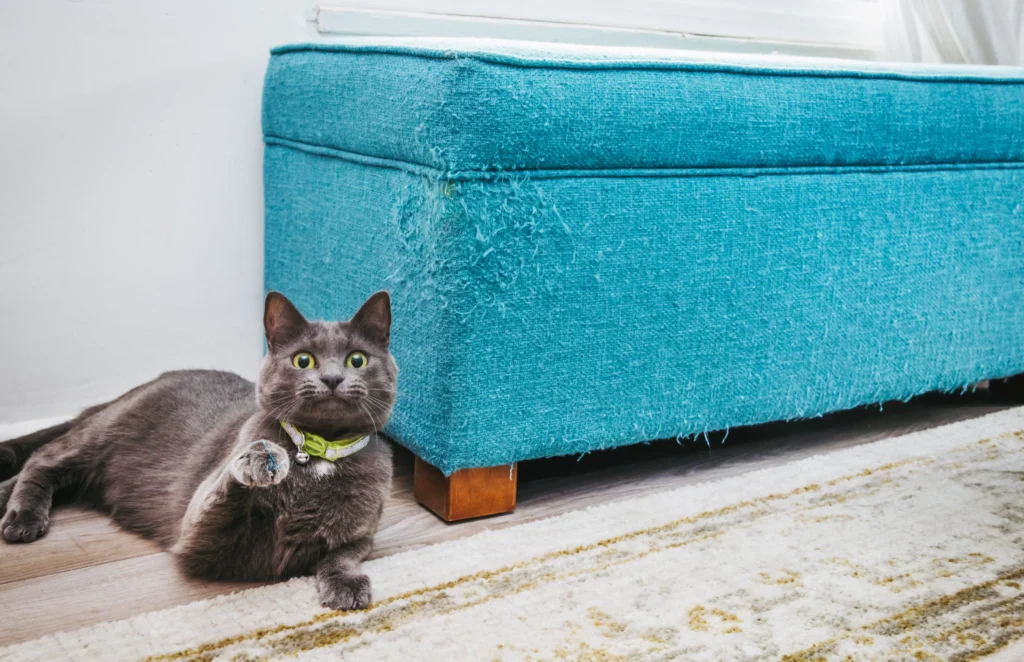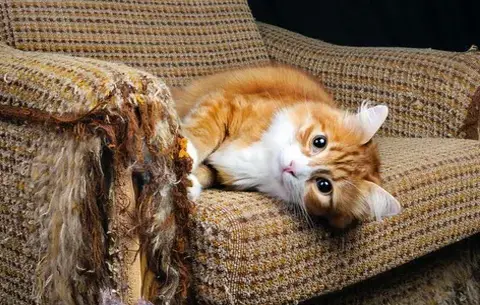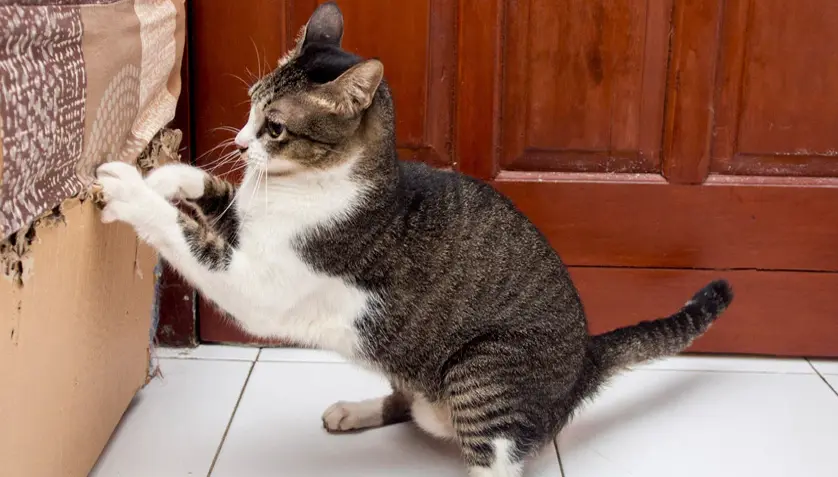How do you prevent your cat from scratching furniture?

Introduction
A. Brief Overview of the Common Issue Cat Owners Face: Furniture Scratching
Cats are instinctive to scratch objects to keep their claws healthy and mark their territory. However, this behavior can become a problem when they choose our furniture as their scratching post.
B. Importance of Addressing the Behavior Early to Protect Furniture and Maintain a Harmonious Home Environment
Early intervention is crucial to prevent damage to your furniture and maintain a peaceful atmosphere at home. By teaching your cat appropriate scratching behavior, you can create a harmonious living space for both you and your feline friend.

Understanding the Behavior
A. Natural Instinct: Explaining Why Cats Scratch
Cats scratch things because it’s a natural thing for them to do. It helps them keep their claws healthy and mark their territory.
B. Identification of Key Reasons Behind Furniture Scratching Behavior
- Marking Territory: Cats scratch to leave their scent and mark their territory. It’s like saying, “This is mine!”
- Maintaining Claw Health: Scratching helps cats shed old claw sheaths and keep their claws healthy and sharp.
- Stretching Muscles: When cats scratch, they stretch their muscles, which feels good for them. It’s like a little kitty workout!
Understanding why cats scratch can help us find ways to redirect this behavior to appropriate scratching surfaces.

Providing Alternative Scratching Surfaces
A. Importance of Offering Suitable Scratching Posts or Pads
It’s important to give your cat options for scratching that they’ll like. This helps steer them away from your furniture.
B. Types of Scratching Posts:
- Vertical Posts: These are tall posts that cats can stretch and scratch on. They mimic tree trunks, which cats love to scratch.
- Horizontal Pads: These are flat surfaces that cats can scratch while lying down. They’re great for cats who prefer scratching horizontally.
- Sisal, Cardboard, or Carpet Options: Scratching posts come in different materials. Sisal, cardboard, and carpet are popular choices that cats enjoy scratching.
C. Placement Considerations:
- Strategic Placement Near Favorite Furniture: Put scratching posts near the furniture your cat likes to scratch. This encourages them to choose the posts instead.
- Multiple Locations Around the Home: Place scratching posts in different areas of your home. This gives your cat options and increases the chance they’ll use them instead of your furniture.
Training Techniques
A. Positive Reinforcement: Reward-Based Training Methods
Positive reinforcement means rewarding your cat when they do something good, like scratching their scratching post instead of the furniture. This encourages them to keep doing the right thing.
B. Discouraging Undesirable Behavior:
- Avoid Punishment: Punishing your cat for scratching the furniture can make them scared or anxious. It’s better to focus on positive reinforcement instead.
- Use Deterrents (e.g., Double-Sided Tape, Citrus Scents): Cats don’t like certain smells or textures. You can use things like double-sided tape or citrus scents on furniture to discourage them from scratching.
C. Redirecting Attention:
Engaging Toys: Give your cat toys they can play with instead of scratching furniture. Toys that move or make noise can be especially enticing.
Interactive Playtime: Spend time playing with your cat every day. This helps burn off their energy and redirects their natural scratching instincts toward toys instead of furniture.
Environmental Modifications
A. Cat-Friendly Furniture Covers or Protectors
These are special covers or protectors designed to go over your furniture to keep it safe from your cat’s scratching.
B. Furniture Arrangement:
- Blocking Access to High-Value Items: If there are certain pieces of furniture your cat loves to scratch, try to block their access to them when you’re not around. This could mean putting something in front of the furniture or moving it to a less accessible area.
- Utilizing Barriers or Deterrents: Barriers like baby gates or deterrents like motion-activated sprays can help keep your cat away from furniture they shouldn’t be scratching.
C. Incorporating Pheromone Products:
- Diffusers: Pheromone diffusers release calming scents that can help reduce your cat’s stress and prevent them from scratching furniture out of anxiety.
- Sprays: Spraying pheromone-based products on furniture can also help deter your cat from scratching by making the area less appealing to them.
Claw Maintenance
A. Regular Trimming: Importance and Technique
Regularly trimming your cat’s claws is important for their health and can help prevent them from scratching furniture. To trim their claws, use special cat nail clippers and be careful not to cut too close to the quick, which is a sensitive part of the claw.
B. Providing Appropriate Scratching Surfaces for Nail Maintenance
Offering your cat suitable scratching surfaces not only helps to redirect their scratching behavior but also aids in maintaining their claws. When cats scratch, they help shed old claw sheaths, keeping their claws healthy and preventing them from becoming overgrown. Make sure to provide scratching posts or pads made of materials like sisal, cardboard, or carpet, which are satisfying for cats to scratch and help maintain their claws.
Seeking Professional Help
A. Seeking advice from a veterinarian or animal behaviorist
If you’re struggling to stop your cat from scratching furniture, it’s a good idea to talk to a veterinarian or animal behaviorist. They can offer expert advice and guidance tailored to your cat’s specific needs.
B. Identification of Underlying Health Issues or Behavioral Concerns
Sometimes, cats scratch furniture because of underlying health issues or behavioral problems. A professional can help identify these issues and provide appropriate treatment or behavior modification strategies.
C. Consideration of Medication or Specialized Training Programs if Necessary
Medication or specialized training programs may sometimes be necessary to address your cat’s scratching behavior. A veterinarian or behaviorist can discuss these options with you and help determine the best course of action for your cat’s well-being.
Conclusion
A. Recap of Key Strategies to Prevent Furniture Scratching
To stop your cat from scratching furniture, provide alternative scratching surfaces, use training techniques like positive reinforcement and redirection, make environmental modifications, maintain their claws, and seek professional help if needed.
B. Importance of Patience and Consistency in Implementing Solutions
Changing your cat’s behavior takes time and consistency. Be patient and stick to the strategies you’ve chosen. Consistency is key to success.
C. Affirmation of the Possibility to Mitigate or Eliminate the Behavior Through Proper Understanding and Intervention
With a proper understanding of your cat’s behavior and consistent intervention, it’s possible to mitigate or even eliminate furniture scratching. Remember, you and your cat can work together to create a happy and scratch-free home environment.
People also ask
Can you train a cat not to scratch furniture?
Yes, through positive reinforcement and providing alternative scratching surfaces.
How do you scratch-proof furniture from cats?
Use covers, and deterrents, and provide suitable scratching posts.
What can you put on furniture to keep cats from clawing?
Double-sided tape, citrus scents, or special furniture protectors.
How do I stop my cat from destroying my couch?
Offer alternative scratching surfaces and use deterrents.
What smell do cats hate to stop scratching furniture?
Citrus, eucalyptus, or lavender scents can deter cats from scratching furniture.
Do cat nail caps work?
Yes, they can be effective in preventing damage from scratching.



